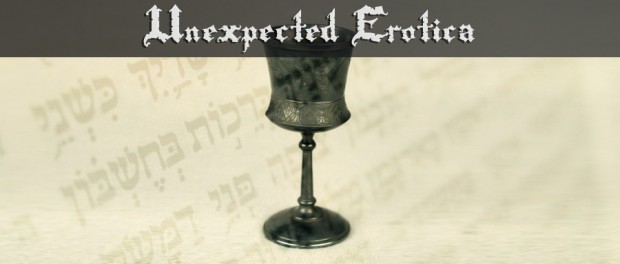Goblet with Wine – Song of Songs 7:2

Song of Songs 7:2a
- KJV: Thy navel is like a round goblet, which wanteth not liquor:
- NIV: Your navel is a rounded goblet that never lacks blended wine.
- NASB: Your navel is like a rounded goblet / Which never lacks mixed wine;
As translated, this is already fairly erotic by implication. The visual of someone pouring wine over a belly so that it fills a belly button is an inherently sensual image. How could this possibly be expanded on to be unexpected erotica?
Well, it all centers on šōr, the word translated as “navel”. This word occurs only three times in the Old Testament: here in the Song, in Proverbs 3:8 (where it’s the “body” that’s healthy due to fear of the Lord), and in Ezekiel 16:4 (where it’s very clearly a newborn’s umbilical cord). So, is “navel” a suitable translation here?
As in other cases when considering translation choices made in uncertainty, we first look to the context of the usage.
First, note the simile: it’s translated “goblet” but the Hebrew word is ‘aggan, which is a large, heavy bowl. In Isaiah 22:24-25, this sort of bowl is depicted as being so heavy it can break the nail it hangs on. Such a notably sizable item doesn’t seem to fit a dainty belly button. Other dishes might make for much more suitable similes for the navel, such as kôs (cup), baqbuq (jar), pak (jug or flask), or even selōnît (a smaller bowl or pan).
Second, we see the wasf (the detailed description of her beauty) working its way up her body in a clear, step-by-step progression from her feet (7:1) to the hair on her head (7:5). Prior to her šōr, we see her feet and upper thighs depicted. After her šōr, we move on to her lower abdomen and her breasts, then on to her neck, eyes, face, head, and hair, completing each area in sequence. The šōr must indicate something between the yārak and the beten.
Prior to her šōr, we see her feet and upper thighs depicted. After her šōr, we move on to her lower abdomen and her breasts, then on to her neck, eyes, face, head, and hair, completing each area in sequence.
The yārak is described by Carr as the “fleshy upper part of the thigh where the leg joins the pelvis”. Hebrew tradition has this firmly seated, as it’s the same place Jacob was touched in Genesis 32:25 during his famous wrestling match that led to his new name “Israel”. To this day, many orthodox Jews still proscribe eating of the muscle which reaches in that same inner, upper location of the hip, in remembrance of this event per Genesis 32:32. There is no doubt here.
The beten is described by Carr as “the rounded lower parts” of the belly, specifically those “below the navel”. This area is also well-settled as it was often used to indicate the womb and any hypothetical fetus carried there. This lower portion of the abdomen is also not in doubt, though the idea of a “rounded” lower belly or it being romantically described as a “mound” or “heap” of anything appalls many modern women with unnatural ideas of the ever-elusive “ideal” female shape. I can think of few modern Western women who would be flattered to have such a description applied to them, despite the centuries of beautiful art depicting rounded bellies on idealized women.
In this progression, a navel as her šōr would be out of sequence. It’s below her belly and above her uppermost inner thighs. Can we see where this is going?
But doesn’t šōr specifically mean “navel”? Well, not exactly. We see a couple distinct meanings in its other two uses, and technically neither is a navel. Ezekiel’s passage is specifically an uncut umbilical cord. Not really the same thing as seen on a grown woman at her wedding feast. Instead, it more broadly means the “centre of the body” according to Franz Delitzsch.
However, Carr points out that beten, the belly, is already the center of the body. The absence of “synonymous parallelism elsewhere [in the longer unit (vv. 1-9)] suggests that no parallelism is intended here either.” In other words, the speaker isn’t just poetically repeating themselves, so this particular šōr can’t be addressing the center.
As noted in The New Jerome Biblical Commentary, this “seems to be a euphemism here, mentioned between the thighs and belly” despite its usual meaning. So this leads some to look for other possible root words with different meanings.
It might help to know the Arabic cognate sir is “used of the ‘secret’ parts”. Some scholars even suggest the root šr means a valley or place to be farmed. Like, say, a garden?
Returning to the context, doesn’t the simile make a bit more sense if we cast aside “navel” and embrace the obvious? Isn’t a vulva a larger bowl than a belly button? Isn’t it reasonable to depict it as perpetually wet? Don’t we recognize the suitability of a common sexual symbol in Near Eastern love poetry — wine — being depicted as ever present in this location?
As Carr summarizes, “there is continual upward movement suggested here, from her upper thighs to her pudenda, to her abdomen to her breasts (v. 3).”
This was already a clearly erotic wasf, and this just confirms it. And as sensual as a bit of wine lapped from a navel seems, it’s nothing compared to a moist vulva endlessly containing a timeless sex symbol.
Originally posted 2016-02-22 08:00:28.


Leave a Reply